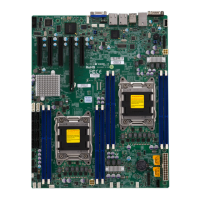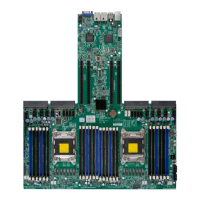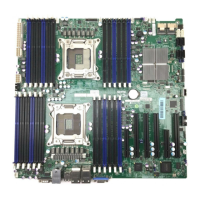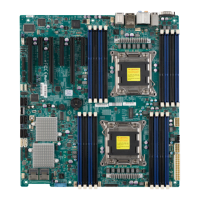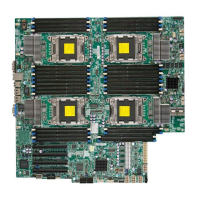Do you have a question about the Supermicro X9DRW-iF and is the answer not in the manual?
Details the motherboard's features, processors, chipset, and memory support.
Outlines the structure of the manual, chapter by chapter.
Explains symbols and important notes used throughout the manual for clarity.
Provides contact information for Supermicro headquarters, Europe, and Asia-Pacific offices.
Provides a general introduction and checklist of items included with the motherboard.
Details the CPU and chipset capabilities, including QPI and PCH features.
Explains the system's health monitoring capabilities, including temperature and voltage.
Specifies requirements for ATX power supplies and connectors for system operation.
Details features like Intel Intelligent Power Node Manager and Management Engine.
Presents industry-standard warnings related to potential bodily injury during installation.
Guides users through the process of installing the CPU and heatsink.
Details the procedure for installing and removing DIMM memory modules.
Explains how to install the motherboard into the chassis, including tools and mounting.
Identifies and defines the various I/O ports and connectors on the back panel.
Describes how to connect various power and internal cables to the motherboard.
Explains how to configure motherboard functions using jumpers.
Covers the SATA and SCU ports, their pin definitions, and connections.
Offers systematic steps to diagnose and resolve system issues before and after power-on.
Provides instructions for safely removing, installing, and disposing of the onboard battery.
Addresses common questions regarding memory support, BIOS updates, and battery handling.
Introduces the AMI BIOS Setup utility and how to navigate its screens.
Covers various advanced BIOS settings for boot features, power, CPU, and chipset configurations.
Details boot settings, including CSM support and boot option priorities.
Covers BIOS security settings, including administrator and user passwords.
Lists beep codes and their corresponding error messages for POST failures.
Guides users on installing drivers and software from the included CDROM.
Explains how to use SuperDoctor III for system monitoring and remote management.
| PS/2 ports quantity | 0 |
|---|---|
| IPMI LAN (RJ-45) port | Yes |
| USB 2.0 ports quantity | 4 |
| Ethernet LAN (RJ-45) ports | 2 |
| PCI Express slots version | 3.0 |
| Memory voltage | 1.35, 1.5 V |
| Memory channels | Dual-channel |
| Maximum RDIMM memory | 512 GB |
| Supported memory types | DDR3-SDRAM |
| Supported memory clock speeds | 800, 1066, 1333, 1600 MHz |
| Maximum UDIMM memory | 128 GB |
| Number of DIMM slots | 16 |
| Supported RDIMM module capacity | 16GB, 1GB, 2GB, 32GB, 4GB, 8GB |
| Supported UDIMM module capacity | 1GB, 2GB, 4GB, 8GB |
| BIOS type | AMI |
| ACPI version | 4.0 |
| BIOS memory size | 128 Mbit |
| RAID levels | 0, 1, 5, 10 |
| Supported storage drive interfaces | SATA II, SATA III |
| Wi-Fi | No |
| LAN controller | Intel® I350 |
| Ethernet interface type | Gigabit Ethernet |
| On-board graphics card model | Matrox G200 |
| Storage temperature (T-T) | -40 - 70 °C |
| Operating temperature (T-T) | 10 - 35 °C |
| Storage relative humidity (H-H) | 5 - 95 % |
| Operating relative humidity (H-H) | 8 - 90 % |
| Supported QPI | 8 GT/s |
| Processor socket | LGA 2011 (Socket R) |
| Intel Xeon series | E5-2600 |
| Processor manufacturer | Intel |
| Processor thermal power (max) | 135 W |
| Processor number of cores supported | 6, 8 |
| Component for | Server |
| Motherboard chipset | Intel® C602 |
| Sustainability certificates | RoHS |
| Depth | 330 mm |
|---|---|
| Width | 305 mm |


